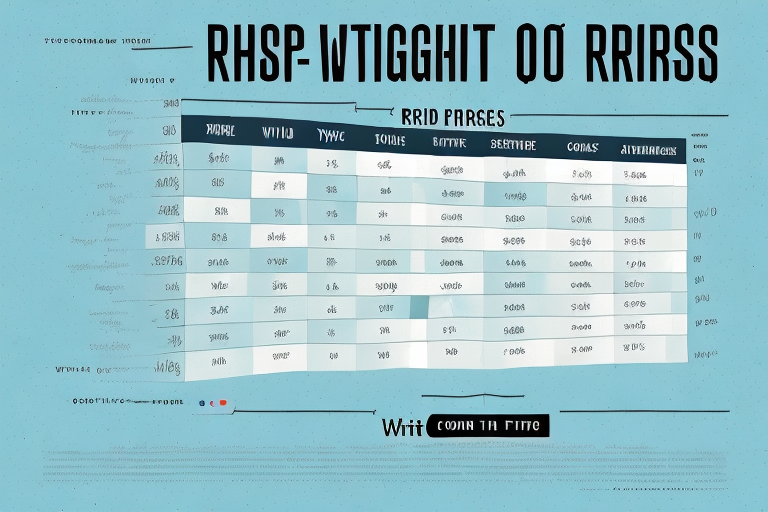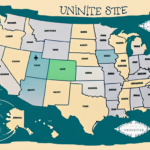Understanding UPS Shipping Rates by Weight Chart
When it comes to shipping packages, understanding the rates charged by UPS is crucial in ensuring you receive the best value for your money. UPS calculates shipping rates based on various factors, including weight, dimensions, and destination. In this article, we will delve into the UPS shipping rates by weight chart and explore all the factors you need to consider when shipping with UPS.
Why It’s Important to Understand UPS Shipping Rates
Shipping rates can significantly impact your bottom line, especially if you frequently ship packages for your business. Understanding how UPS calculates its rates can help you determine the most cost-effective strategies for your shipments. Additionally, knowing ways to save on these rates can help reduce your expenses and increase your profits.
One critical factor to consider when understanding UPS shipping rates is the weight and size of your package. UPS uses a dimensional weight calculation, meaning the size of your package can affect the shipping cost, even if it is not particularly heavy. By optimizing the size and weight of your packages, you can potentially save money on shipping costs.
Another important consideration is the destination of your package. UPS offers different shipping options, such as ground, air, and international, each with their own rates and delivery times. By understanding the various options available and their associated costs, you can choose the best shipping method for your needs and budget.
How UPS Calculates Shipping Rates
UPS calculates shipping rates using a combination of weight, dimensions, and destination. For packages weighing up to 150 lbs, UPS uses the greater of the actual weight or the dimensional weight to determine shipping costs. However, for packages over 150 lbs, rates are based solely on their weight. Additionally, factors such as distance, time of year, and fuel surcharges can also influence shipping rates.
UPS offers various shipping options, including ground, air, and international shipping. Each option has its own set of rates and delivery times. Ground shipping is typically the most affordable option but may take longer to arrive at its destination. Air shipping is faster but more expensive, while international shipping rates can vary greatly depending on the destination country and the package’s weight and dimensions.
UPS also provides additional services that can affect shipping rates, such as signature confirmation, insurance, and Saturday delivery. These services offer added security and convenience but come at an extra cost. Customers can choose which services to add to their shipment and view the updated shipping rates before completing their order.
Factors Influencing UPS Shipping Rates
Several factors influence UPS shipping rates:
- Weight and Size of the Package: Both actual and dimensional weight are considered.
- Destination: Domestic vs. international destinations have different rate structures.
- Type of Shipping Service: Options include ground, air, and international shipping.
- Additional Services: Services like signature confirmation, insurance, and Saturday delivery.
- Time of Year and Fuel Surcharges: Peak seasons and fluctuating fuel costs can impact rates.
- Type of Item: Hazardous materials, fragile items, and items requiring special handling may incur additional fees.
- Insurance Coverage: Higher insurance coverage increases the shipping rate.
Navigating the UPS Weight Chart
The UPS weight chart is a valuable tool for determining the cost of your shipment. It is divided by zones and displays the cost of shipping packages based on their weight. To use this chart effectively, you need to determine your package’s weight and destination zone. Once you have these details, you can refer to the weight chart to find the corresponding shipping rate.
It’s important to note that the UPS weight chart is regularly updated, so always check for any changes before shipping your package. Additionally, the weight chart only applies to packages shipped through UPS and may not be applicable to other shipping carriers. Comparing rates and services from different carriers can help ensure you’re getting the best deal for your shipment.
Dimensional Weight vs. Actual Weight
Understanding the difference between dimensional weight and actual weight is essential for accurately calculating shipping costs. Actual weight is the package’s weight, while dimensional weight is a calculation based on the package’s size. UPS uses the greater of the two weights to determine shipping rates, so it’s important to verify which weight applies to your shipment before finalizing the shipping cost.
Dimensional weight is calculated by multiplying the package’s length, width, and height and then dividing the result by a dimensional factor. For example, UPS uses a dimensional factor of 139 for packages measured in inches. Larger packages that take up more space on a carrier’s vehicle, even if they are relatively lightweight, may result in higher shipping costs due to dimensional weight calculations.
By understanding these weight measurements, you can optimize your package dimensions to avoid unnecessary shipping costs.
Tips for Saving Money on UPS Shipping Rates
To save money on UPS shipping rates, consider the following strategies:
- Optimize Package Size and Weight: Avoid dimensional weight charges by minimizing package dimensions and weight.
- Compare Shipping Options: Evaluate different shipping services (ground, air, international) to choose the most cost-effective option.
- Use UPS My Choice: This service allows you to select the delivery date and time that best fits your schedule, potentially avoiding rush shipping fees.
- Choose UPS Ground for Domestic Shipments: UPS Ground is often the most economical option for non-time-sensitive packages.
- Consider UPS Worldwide Expedited for International Shipments: This option offers faster delivery times than standard international shipping at a lower cost than express services.
Understanding UPS Surcharges and Fees
In addition to regular shipping rates, UPS charges various surcharges and fees for different services and situations. These include fees for delivery to remote locations, oversized packages, and residential deliveries. Understanding these surcharges and fees is crucial to avoid unexpected charges and to accurately estimate your shipping costs.
Comparing UPS Rates to Other Shipping Carriers
While UPS is one of the largest and most popular shipping carriers, it's beneficial to compare rates with other carriers to ensure you're getting the best value for your money. Consider evaluating FedEx, USPS, or DHL rates and services before selecting a carrier. Different carriers may offer competitive rates, faster delivery times, or specialized services that better fit your shipping needs.
How to Negotiate Better Rates with UPS
Negotiating better rates with UPS can be challenging, but it's possible with the right strategies:
- Bundle Shipment Volume: Increasing your shipping volume can provide leverage for negotiating lower rates.
- Leverage Competition: Use competitive quotes from other carriers to negotiate better rates with UPS.
- Use a Shipping Broker: Brokers can negotiate on your behalf, potentially securing better rates.
- Analyze Shipping History: Request a detailed analysis of your shipping history to identify areas for cost improvement or receive tailored advice from UPS representatives.
Common Mistakes to Avoid When Using the UPS Weight Chart
One of the most common mistakes when using the UPS weight chart is entering incorrect destination zip codes or package weights. Always review the information before finalizing your shipment to ensure accuracy. Other mistakes include:
- Errors in Choosing Services: Selecting the wrong shipping service can lead to higher costs or delayed deliveries.
- Packing Inefficiencies: Overpacking or using inappropriate packaging materials can increase the weight and dimensions, leading to higher rates.
By avoiding these errors, you can ensure accurate rate calculations and optimize your shipping costs.
Using Technology to Streamline the Shipping Process with UPS
Technology can make the shipping process more efficient and manageable. UPS offers a range of digital tools that streamline shipping, including:
- UPS Online Platform: Manage your shipments, track packages, and print shipping labels through the UPS website.
- UPS Mobile App: Access shipping features on the go, including package tracking and rate calculations.
- API Integrations: Integrate UPS shipping capabilities with e-commerce platforms for automated shipping processes.
- Package Tracking Services: Keep track of your shipments in real-time to ensure timely deliveries.
Leveraging these technologies can enhance your shipping efficiency and provide better control over your logistics operations.
Best Practices for Packing and Preparing Your Shipment
The way you pack and prepare your shipment can significantly impact its cost. Implement the following best practices to optimize your packaging:
- Use Appropriate Packaging Materials: Ensure your items are protected with the right materials to prevent damage during transit.
- Label Your Packages Correctly: Proper labeling facilitates easy identification and handling, reducing the risk of delays or errors.
- Accurate Weight and Dimensions: Measure and weigh your packages accurately to avoid additional charges due to discrepancies.
- Optimize Package Size: Use the smallest possible package size that adequately protects your items to minimize dimensional weight charges.
By following these practices, you can reduce shipping costs and ensure your packages arrive safely and on time.
Frequently Asked Questions about UPS Shipping Rates by Weight Chart
How often is the UPS weight chart updated?
UPS updates its weight chart regularly to reflect changes in rates and surcharges. It is important to check for any updates on the UPS website before shipping your package.
Do UPS weight charts apply to other carriers?
No, UPS weight charts are specific to UPS and may not be applicable to other shipping carriers. Each carrier has its own rate structures and weight calculations.
Can I compare rates from different carriers?
Yes, it’s always a good idea to compare rates and services from different carriers to ensure you’re getting the best deal for your shipment. Use online comparison tools or consult the carriers' websites for accurate rate information.
We hope this article has helped you understand the UPS shipping rates by weight chart and the factors you need to consider when shipping with UPS. By following these guidelines and tips, you can make informed decisions based on your specific shipping requirements and take control of your shipping costs.






















